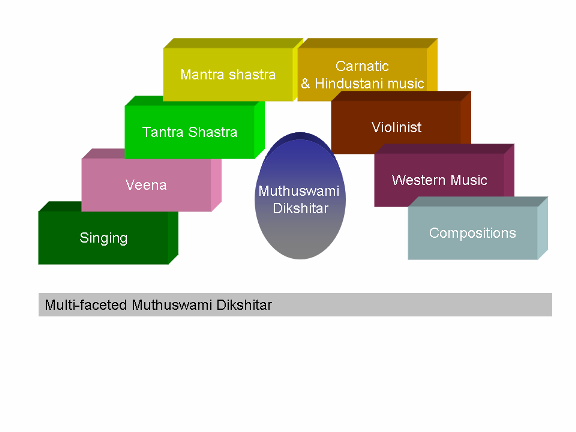Muthuswani Dikshitar lived from 1775 to 1835.
He was born in the town of Tiruvarur, just like Sri Tyagaraja and Shyama Shastri. He was one among the Classical Music Trinity. His parents were Ramaswami Dikshitar and Bhageeratamma. His father was a classical singer himself. Muthuswami learnt classical music from his father. He also became an expert in “Veena” instrument, sanskrit language, “tantra shastra”, “mantra shastra”, astrology, “alankara shastra”. He studied the “Vedas” and became a “Agnihotri”. Chidambara natha Yogi was his mentor and teacher. He stayed with his Guru in Kashi for 5 years to learn “Mantras”. Here he also learnt Hndustani Classical music. It is believed that when Muthuswami took bath in the Ganges and finished his prayers, a “Veena” came into his hands by itself. Muthuswami Dikshitar also was familiarized with western music during his early childhood. While returning from Kashi, it is believed that Lord Subramanya appeared before him in Tiruttani. All the education that he got so far have laid a strong foundation for all that Muthuswami offered later on. He was a “Vainika-Gayaka” who not only was a great singer but also played on the Veena while he sang.
He was also a gifted composer who composed several slow paced, intricate rhythm patterned compositions which went well with the Veena. Muthuswami Dikshitar started composing songs at the early age of 16. His pen name was “Guruguha”. Which means that, every song he composed had the word “Gurugha” incorporated.
Compostions:
Muthuswami Dikshitar’s compositions uniqueness come not only from their ingenuity but also their significance in cosmic manifestation. His most important compositons can be categorized as –
1. Nava Gruha Kritis – In praise of the Nava Gruhas depicted by Sun, moon and the nine influences or cosmic planets.
2. Nava Avarana Kritis – These are 11 kritis including invocation kriti, and conculsion kriti. The main 9 very significant compositions are each in favor of the 9 Avaranas of the Sri Chakra. Sri Chakra also signifies the goddess “Kamalamba” or “Tripura Sundari” . Each composition explains the significance of each enclosure of the Sri Chakra and its geometry.
3. Pancha Linga Kritis –
4. Guruguha Kritis – In praise of his Guru.
Muthuswami inducted violin into Carnatic music. He has composed Kritis in all the 72 Melakarta Raagas ranging with all the Sooladi Sapta Taalas. Thus some rare Raagas have been given compositions by him. His compositions talk about the temples he visited, their state of affairs at that time.
Some popular examples of Muthuswami Dikshitar Kritis are –
1.”Vatapi Ganapatim” – set to “Raaga Hamsadhwani”
2.”Annapoorne” Set to “raaga Sama”
3.”Mahaganapathim” – set to “raaga Naata”
Muthuswami Dikshitar has done extensive work as described above and much more which is beyond the scope of this article. The various dimensions of his work can be shown in the image below –
